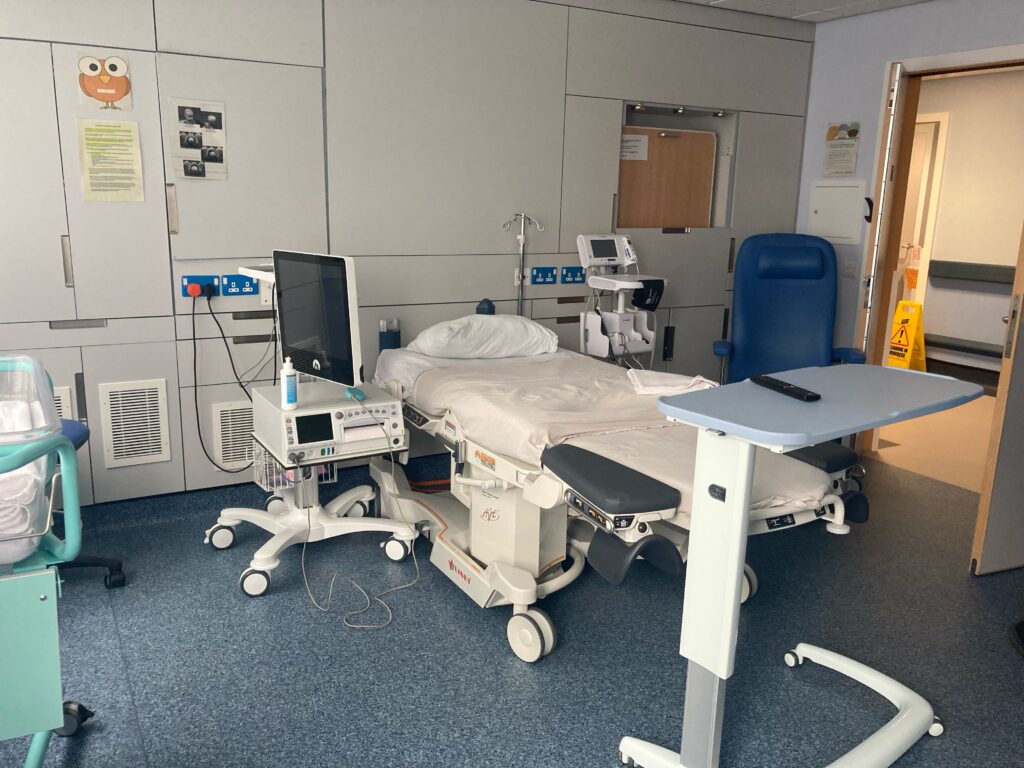Deciding where you want to give birth to your baby is an important decision. Clinical safety is a significant factor most women consider when choosing where to give birth but we know that women also value feeling comfortable, safe and in control and that these factors can have a beneficial impact on your labour. Indeed, we know from evidence that your birth environment can affect how your labour progresses and how you feel about your birth.
During your antenatal care, your midwife (or doctor) will invite you to discuss the options that are available to you in NHS Lothian.
What matters to you and your personal preferences are central to this decision. Your midwife (or doctor) will always take this into account when helping you plan where to give birth. They will make a recommendation based on your pregnancy and your individual circumstances, as well as on local and national guidelines. They will discuss this with you so that you understand the reasons (risks and benefits) for the recommendation. However, you can choose to accept this recommendation or you can choose a different option that feels right for you. In NHS Lothian we are always happy and keen to have open conversations with women, birthing people and their families, to find the most appropriate, safe and person-centred care.
This page provides information based on research about the various options of where to give birth and their associated outcomes. In NHS Lothian we offer three settings in which you can have your baby: a birth at home, a birth in the Lothian Birth Centre (midwifery-led unit) or in one of our two obstetric units (Labour Ward).
HOMEBIRTH
What does the evidence say?
NHS maternity services follow the guidance presented by NICE (National Institute for Health and Care Excellence). The current guidance from NICE on home birth is based on the 2011 Birthplace study, a large study conducted in the UK which compared the safety of birth in four settings for women with uncomplicated, low-risk pregnancies. The study looked at the safety of different places of birth for healthy women with straightforward pregnancies.
- According to this research, for women with an uncomplicated, low-risk pregnancy who are having their second or subsequent baby, there are no significant differences in outcomes for mother and baby between planned births at home or in a midwifery unit compared with planned births in an obstetric unit.
- For first time mothers with an uncomplicated, low-risk pregnancy, there was no difference in outcomes for mothers giving birth at home compared to a midwife-led or obstetric unit. However, homebirth was associated with an increase in poor outcomes for the baby (9 per 1,000 for births at home compared to 5 per 1,000 in a midwife-led or obstetric unit).
- Transfer rates for first-time mothers were 45% – this can be due to complications during labour or after birth or for requests for further pain relief.
- Transfer rates for mothers having their second or subsequent baby were 12%.
Benefits: You are more likely to feel more relaxed and in control in familiar surroundings – this can help the progress of your labour. It is your home so you have control over your birthing environment (lighting, music, who is with you, etc…) which is linked to better emotional outcomes for mothers. Research has shown that less pain relief is used in the home birth setting. You are more likely to be cared for by a midwife you know, although we cannot guarantee this.
Risks: If complications arise, it could be that transfer to one of the obstetric units will be recommended and this will be discussed with you so that you understand the reasons and can make a decision. Transfer is usually done by ambulance (depending on the stage of labour). The transfer time will vary based on where you live and the time of day.
For consideration: If you wanted access to additional pain relief, such as opiate injections or an epidural, this is not available at home. It is always possible to start labouring at home and transfer at any time, should you wish to access these forms of pain relief.
Homebirth in NHS Lothian
In NHS Lothian there is a dedicated team of midwives who specialise in supporting women to give birth at home: they are called the Homebirth team. If you are considering giving birth at home, you will be referred to a midwife from the homebirth team who will provide your antenatal care – normally in your home. The homebirth team, supported by other community midwives where required, will go ‘on call’ for you from 38 weeks’ gestation. The midwives will arrange for equipment and medication to be delivered to your home before going on-call for you. During labour, you will be cared for one-to-one by a midwife, and a second midwife will be called during birth to offer support. The midwives caring for you during labour and birth will be keeping a close eye on you and your baby. In some cases, when there are concerns for yourself or your baby, they may recommend a transfer to an obstetric unit (labour ward). This will be discussed with you so that you understand the reasons and can make a decision.
MIDWIFE-LED UNIT
What does the evidence say?
According to research from the Birthplace study (2011), midwife-led units appear to be safe for the baby and offer benefits for women with an uncomplicated, low-risk pregnancy. The study looked at the safety of different places of birth for healthy women with straightforward pregnancies.
- For births in midwife-led units there were no significant differences in outcomes for the baby compared with births in an obstetric unit.
- The rates for interventions during labour and birth – including assisted birth and caesarean birth – were significantly lower than for women who gave birth in an obstetric unit, in particular for women without complications at the start of labour.
- Transfer rates for first-time mothers were 40% – this can be due to complications during labour or after birth or for requests for further pain relief.
- Transfer rates for mothers having their second or subsequent baby were 12%.
Benefits: Being in a comfortable, home-like environment may help you to relax more and feel in control, which can help the progress of your labour. The midwifery team are committed to supporting labouring women and birthing persons in a holistic way. They provide one-to-one care that focuses on each individual’s preferences for birth.
Risks: We do not recommend giving birth in the Birth Centre if you have any significant factors which may make birth more complex. However, it is possible to discuss your personal circumstances with the charge midwife – and the wider team if necessary – and look at a personalised plan of care.
For consideration: We offer various forms of pain relief, including aromatherapy oils, TENS machines, the birthing pool, gas and air (Entonox) and sterile water injections.
Epidural analgesia is not available in the birth centre but you can start labouring in the birth centre and transfer at any time to the labour ward, should you wish to access this form of pain relief.
Midwife-led Unit in NHS Lothian

In NHS Lothian, you have the option to give birth in the Lothian Birth Centre, a midwife-led unit alongside the Maternity Unit at the Royal Infirmary of Edinburgh. This option is open to everyone in the Lothians, whether you live in Edinburgh, East Lothian, Midlothian or West Lothian.
Midwife‑led units offer a more ‘home‑like’ environment and are designed to support low risk birth. The Lothian Birth Centre at the Royal Infirmary of Edinburgh is a midwife-led unit in the same building as the obstetric unit. On arrival, you will be welcomed directly into the birth centre. During labour you will be cared for one-to-one by a midwife. The midwives caring for you during labour and birth will be keeping a close eye on you and your baby, ensuring they adhere to your personal preferences as highlighted in your birth plan if you have got one or by discussing them with you as your labour progresses. In some cases, when there are concerns for yourself or your baby, they may recommend a transfer to the labour ward (obstetric unit) nearby. This will be discussed with you so that you understand the reasons and can make an informed decision. The neonatal unit is also nearby in case your baby needs any additional care.
OBSTETRIC UNIT
(also called LABOUR WARD)
What does the evidence say?
In the 2011 Birthplace Study which looked at the safety of different places of birth for healthy women with straightforward pregnancies.
- The rates for interventions during labour and birth – including episiotomy, assisted birth and caesarean birth – were significantly higher for women who gave birth in an obstetric unit, including for women without complicating conditions at the start of care in labour.
- 7% of women with an uncomplicated, low-risk pregnancy who gave birth in an obstetric unit had an assisted birth. This rate was 5% for women giving birth in an alongside midwife-led unit and 2% for those giving birth at home.
- 11% of women with an uncomplicated, low-risk pregnancy giving birth in an obstetric unit had a caesarean birth. This rate was 4% for women giving birth in an alongside midwife-led unit and 3% for those giving birth at home.
Benefits: Access to additional pain relief, such as opiate injections or an epidural, is available without needing to transfer.
Risks: The rates for requiring an intervention during labour and birth – including episiotomy, assisted birth or caesarean birth – are higher in an obstetric unit, including for women without complications at the start of care in labour.
Obstetric Units in NHS Lothian

In NHS Lothian there are two obstetric units (also called labour wards). One at the Royal Infirmary of Edinburgh and one at St John’s Hospital in Livingston. Labour wards offer a whole range of medical facilities, although the environment is made to feel as relaxed and comfortable as possible. When you are in labour you will be cared for one-to-one by a midwife. A team of obstetric doctors and anaesthetists will be on hand and can be called for assistance if required.
If you have any significant factors which can make labour and birth more complex for you and your baby, your midwife or doctor will recommend that you give birth in an obstetric unit. This will be discussed with you so that you understand the reasons (risks and benefits) and can make a decision based on your personal preferences.
Obstetric doctors and anaesthetists are available at all times and there is direct access to operating theatres should interventions be recommended. There is direct access to the neonatal unit should your baby require support after birth.

“Childbirth is a transformative experience both physically and emotionally and midwives are at the centre of it. We support families to have the best start, preparing them not only for the process of childbearing and birth but also to become the best possible parents and we support them to develop environments where their babies can thrive into healthy adults”.
Mercedes Perez-Botella, Director of Midwifery NHS Lothian













